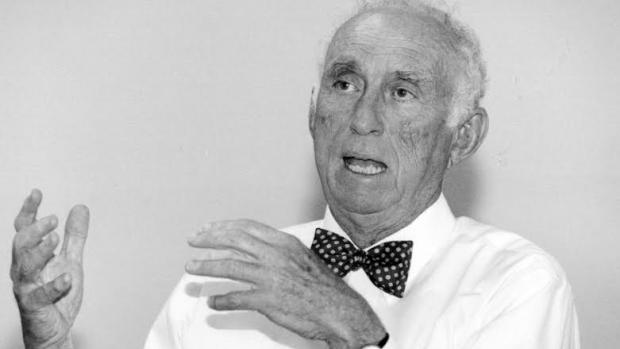In Memoriam: Martin L. Perl
The Nobel Laureate and Alum Made a Lasting Mark on the School and on the World

Dr. Martin L. Perl did not believe in holing up around the clock in his lab. “Limit your working hours,” he told the attendees of a Presidential Lecture he gave in 2008 at his alma mater, the NYU Polytechnic School of Engineering. “Creativity and innovation require relaxation time and non-technical activities.” There were undoubtedly those in the audience who found it surprising advice, coming as it did from one of the most celebrated physicists of his era. Perl—who had earned his bachelor’s degree in 1948 from what was then known as the Polytechnic Institute of Brooklyn—was, after all, a recipient of the two most prestigious scientific awards given in his field: the Wolf Prize in Physics (1982) and the Nobel Prize in Physics (1995).
If it was surprising that such an accomplished scientist advocated relaxing from time to time, it was equally surprising that one decorated with so many laurels possessed such humility and kindness. “He was an incredibly pleasant and down-to-earth person,” Professor Iraj Kalkhoran, who helped organize Perl’s visit to the school, remembers. “He was not only a true scientist but also a great man. Every time I spoke with him, I learned something new.”
.jpg) Perl had enrolled at the Polytechnic Institute, he often told interviewers, because his parents, immigrants who had fled Russia to escape anti-Semitism and poverty, viewed engineering as a stable way to earn a living. He always graciously reminded his audience that although he later decided to pursue physics rather than the chemical engineering in which he had majored, the school was instrumental in giving him a solid foundation for his scientific enquiries. “The skills and knowledge I acquired at the Polytechnic Institute have been crucial in all my experimental work,” he wrote in a statement to the Nobel Committee, “the use of strength of materials principles in equipment design, machine shop practice, engineering drawing, practical fluid mechanics, inorganic and organic chemistry, chemical laboratory techniques, manufacturing processes, metallurgy, basic concepts in mechanical engineering, basic concepts in electrical engineering, dimensional analysis, speed and power in mental arithmetic, numerical estimation (crucial when depending on a slide rule for calculations), and much more.”
Perl had enrolled at the Polytechnic Institute, he often told interviewers, because his parents, immigrants who had fled Russia to escape anti-Semitism and poverty, viewed engineering as a stable way to earn a living. He always graciously reminded his audience that although he later decided to pursue physics rather than the chemical engineering in which he had majored, the school was instrumental in giving him a solid foundation for his scientific enquiries. “The skills and knowledge I acquired at the Polytechnic Institute have been crucial in all my experimental work,” he wrote in a statement to the Nobel Committee, “the use of strength of materials principles in equipment design, machine shop practice, engineering drawing, practical fluid mechanics, inorganic and organic chemistry, chemical laboratory techniques, manufacturing processes, metallurgy, basic concepts in mechanical engineering, basic concepts in electrical engineering, dimensional analysis, speed and power in mental arithmetic, numerical estimation (crucial when depending on a slide rule for calculations), and much more.”
Kurt Becker, the School of Engineering’s Vice Dean for Academic Affairs, recalls that despite his practical streak and his support of the school’s focus on invention, innovation, and entrepreneurship, Perl was “an unapologetic advocate of blue sky research.” That research led in the 1970s to the discovery of a third family of elementary constituents of matter: the tau lepton. While identical in almost every respect to the electron, the tau lepton was 3,500 times its mass; additionally, unlike its stable cousin, the tau electron survived for only a third of a trillionth of a second. Explaining the significance of the discovery, the Nobel Committee asserted that Perl was helping to answer the most important physical and philosophical questions Mankind has ever posed: “What does this Universe consist of? What are the smallest constituents of the Universe and what are their properties? What can they tell us of the history of the Universe and of its future?"
Perl was, however, also interested in more prosaic questions and was happy to advise fledgling scientists about their work and careers. “Don’t try to fit yourself into any particular image of what a scientist should be,” he wrote in the 2004 book One Hundred Reasons to Be a Scientist, edited by Dean and President of Engineering at NYU Katepalli Sreenivasan. “You don’t have to be a mathematical genius, you don’t have to be mechanically handy. You just have to want to find out new things about nature...The great joy will then occur when you are the first to know an answer.”
As the first to know about the tau lepton, Perl brought not only great joy but great pride to the entire NYU Polytechnic School of Engineering community.





